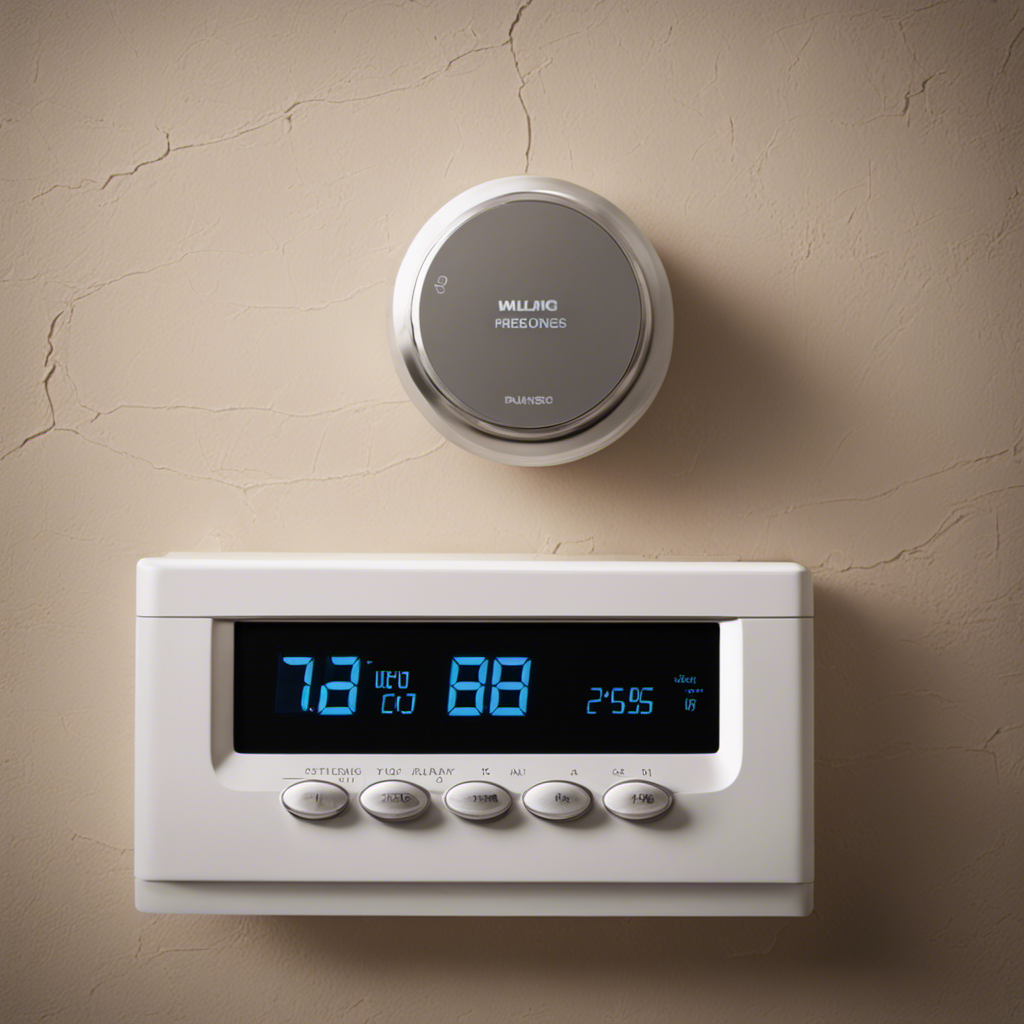Are you experiencing inconsistent temperature control, constantly adjusting your thermostat, or facing high energy bills? It may be time to consider if you need a new thermostat in your house.
In this article, we will explore the signs that indicate your thermostat may be due for an upgrade. By identifying outdated technology, inaccurate temperature readings, and a lack of smart thermostat features, we aim to serve you with the knowledge necessary to make an informed decision for your home.
Key Takeaways
- Inconsistent temperature control can be a sign that you need a new thermostat in your house.
- Constantly adjusting the thermostat and an inability to achieve a comfortable temperature are indicators of thermostat malfunction.
- Outdated thermostat technology can lead to inefficiency, unreliable performance, and compatibility issues with newer HVAC systems.
- Inaccurate temperature readings and high energy bills are also signs that you may need a new thermostat.
Inconsistent Temperature Control
When experiencing inconsistent temperature control, it is important to assess the functionality of your thermostat. Your thermostat plays a crucial role in maintaining a comfortable living environment by regulating the temperature in your home.
To ensure optimal performance, regular thermostat maintenance is essential. Start by checking the thermostat’s batteries and replacing them if needed.
Dust and debris can also accumulate over time, affecting its accuracy. Clean the thermostat carefully using a soft cloth or brush.
If the issue persists, it may be necessary to perform some thermostat troubleshooting. Check the wiring connections and ensure they are secure.
Additionally, familiarize yourself with the thermostat’s settings and verify that they are correctly configured.
Constantly Adjusting the Thermostat
If you find yourself constantly adjusting the thermostat in your house, it may be a sign that your thermostat is not functioning properly.
Constantly adjusting the thermostat can be frustrating, especially when you are unable to achieve a comfortable temperature in your home.
This frequent temperature changes can be a result of a thermostat malfunction. A malfunctioning thermostat may not accurately sense the temperature in your house, causing it to constantly turn on and off or fail to maintain a consistent temperature.
This can lead to discomfort, energy wastage, and higher utility bills.
If you are experiencing frequent temperature changes and find yourself constantly adjusting the thermostat, it is advisable to have a professional inspect your thermostat for any malfunction and consider replacing it if necessary.
Outdated Thermostat Technology
Both inefficient and unreliable, outdated thermostat technology can greatly impact the comfort and energy efficiency of your home.
One of the main issues with outdated thermostats is wiring problems. Over time, the wiring in these older models can become frayed or deteriorated, leading to connection issues and potential malfunctions. This can result in inaccurate temperature readings and an inability to properly control your heating and cooling system.
Additionally, compatibility problems can arise with outdated thermostats when trying to integrate them with newer HVAC systems. This can lead to limited functionality and an inability to take full advantage of the features and efficiency offered by modern systems.
Upgrading to a newer, more advanced thermostat can help eliminate these issues and improve the overall performance of your HVAC system.
Inaccurate Temperature Readings
Inaccurate temperature readings, yet common in malfunctioning thermostats, can lead to discomfort and inefficient energy usage in your home. Faulty temperature sensors are often the culprits behind these inaccuracies.
These sensors are responsible for measuring the temperature of the air and transmitting the information to the thermostat. When they become faulty or damaged, they can provide incorrect readings, causing your thermostat to misjudge the temperature in your home.
To address this issue, thermostat calibration is necessary. Calibration ensures that the temperature readings on your thermostat align with the actual temperature in your home. By calibrating your thermostat and replacing faulty temperature sensors if needed, you can ensure accurate temperature control and create a more comfortable and energy-efficient living environment.
High Energy Bills
Frequently, skyrocketing energy bills can indicate that your thermostat may need to be replaced. If you notice a significant increase in your energy costs, it is important to consider the health of your thermostat. A malfunctioning thermostat can cause your heating and cooling system to work harder than necessary, resulting in excessive energy consumption and higher bills.
To prevent this, regular thermostat maintenance is crucial. Ensure that your thermostat is clean and free from dust and debris. Additionally, consider implementing energy-saving tips to reduce your energy usage. For instance, programming your thermostat to adjust the temperature when you’re away from home or during sleeping hours can lead to significant energy savings.
Lack of Smart Thermostat Features
Furthermore, if your thermostat lacks smart features, such as programmable schedules and remote control capabilities, it may be time to consider upgrading to a more advanced model.
Smart thermostats offer numerous benefits that can greatly enhance your comfort and convenience. With programmable schedules, you can set specific temperature settings for different times of the day, ensuring optimal comfort while saving energy.
Additionally, smart thermostats often have compatibility with other smart devices, allowing you to control and monitor your home’s temperature remotely. This means that even if you’re away from home, you can adjust the temperature settings to ensure a comfortable environment upon your return.
Remote temperature monitoring is also a valuable feature, allowing you to keep track of your home’s temperature from anywhere, providing peace of mind and the ability to make adjustments as needed.
Upgrading to a smart thermostat with these advanced features can greatly improve your overall comfort and energy efficiency.
Frequently Asked Questions
How Often Should I Replace My Thermostat?
The lifespan of a thermostat varies, but generally, it can last for several years. Signs of a failing thermostat include inconsistent temperature, unresponsive controls, and frequent system cycling. Regular maintenance and monitoring can help determine if a replacement is needed.
Can I Install a New Thermostat Myself, or Do I Need to Hire a Professional?
When considering the installation of a new thermostat, one may wonder whether it is possible to do it oneself or if hiring a professional is necessary. Both DIY installation and professional installation have their benefits.
Are There Any Signs That Indicate My Thermostat Is Malfunctioning?
If you’re experiencing issues with your thermostat, such as inaccurate temperature readings or unresponsive controls, it may be a sign of malfunctioning. Troubleshooting thermostat problems is recommended before considering the need for a new one.
How Can I Determine if My High Energy Bills Are Due to a Faulty Thermostat?
Determining thermostat problems and troubleshooting thermostat issues can help identify if a faulty thermostat is causing high energy bills. Monitoring energy consumption, checking for temperature inconsistencies, and consulting a professional can assist in diagnosing the issue.
Are There Any Benefits to Upgrading to a Smart Thermostat, Besides Energy Savings?
Upgrading to a smart thermostat offers numerous benefits beyond energy savings. Smart thermostat features, such as programmable schedules and remote access, provide convenience and comfort. Additionally, smart home integration allows for seamless control and automation of your home’s temperature.


